Provence style kitchen interior design
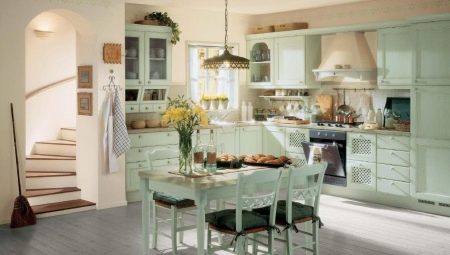
The kitchen should first of all create a calm and favorable mood. It is very easy to form it using the Provence style. However, you need to know the basic subtleties and nuances.
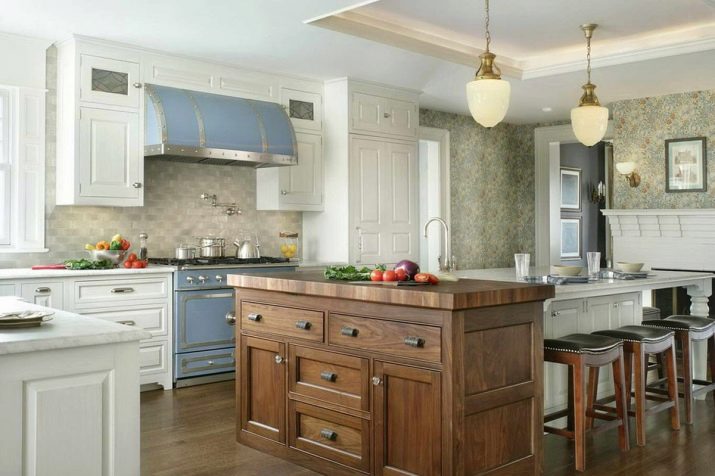
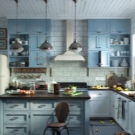
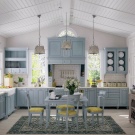
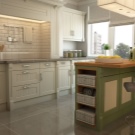
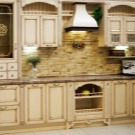
Style features
The interior in the spirit of Provence is ideal for a small apartment. There, an abundance of light colors helps to visually expand the room. Indispensable motives for this style will be:
- natural atmosphere;
- cosiness;
- visual warmth;
- sunny days.

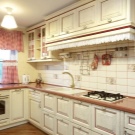

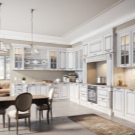


Only when all this is embodied can we talk about the ideal execution of stylistic canons. The Provencal approach implies a mandatory rejection of some components:
- modern furniture samples;
- golden and silver elements;
- parts made of stainless steel.
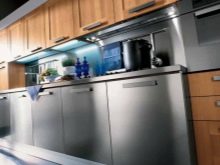
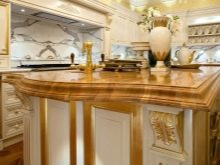
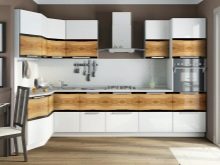
Entering a room decorated in the Provence style, people find that everything around them is somehow old and has been used for a long time. This design is best revealed when not only the kitchen is properly decorated, but also the rest of the rooms. To better imagine the situation in this style, you need to take into account that it focuses on old rustic interiors.
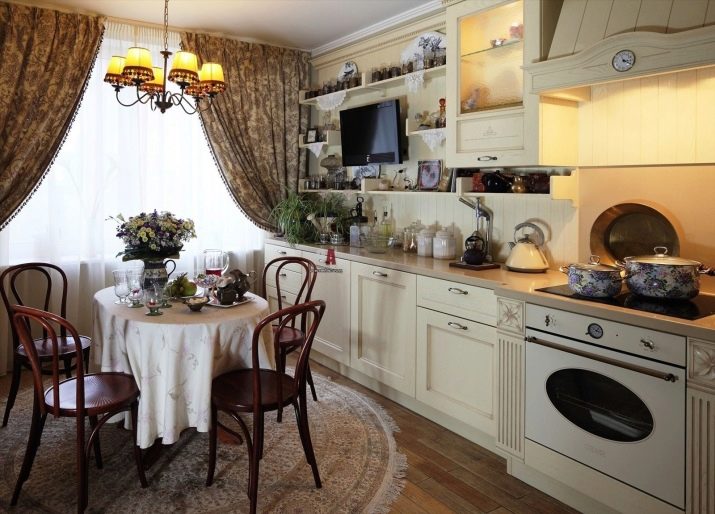
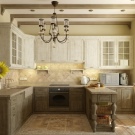
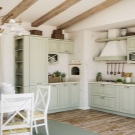
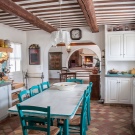
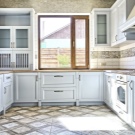
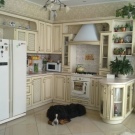
The necessary coloring always implies the use of faded tones.
But before you get acquainted with the descriptions of specific projects, you need to figure out how Provence differs from the classics. In a classic setting, solutions are used to show greatness and make the room more pompous. In the Provencal style, any visual overload and oversaturation of space is categorically unacceptable. It is less pretentious and will suit those who just want to create a decent, beautiful looking and cozy space. The difference is also expressed in the cost of a particular interior - the classics, in contrast to Provence, can not be afforded by everyone.
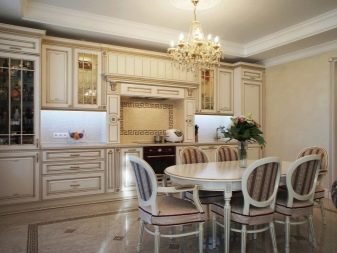
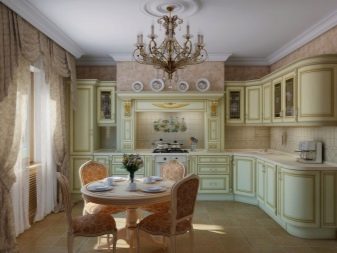

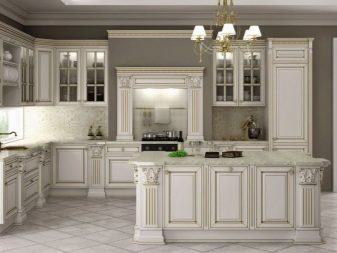
Color spectrum
Traditionally, Provence is associated with white. But it is not necessary to use it in its pure form. A very good combination is formed by white and blue tones. Choosing a specific color, you need to clearly understand what effect should be achieved. In some cases, it is practiced to create sharp contrasts between white and blue. (up to deep blue) paints.
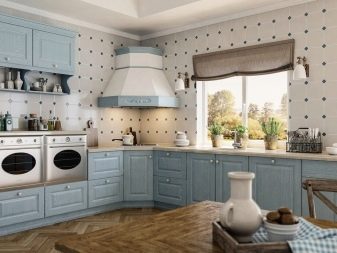
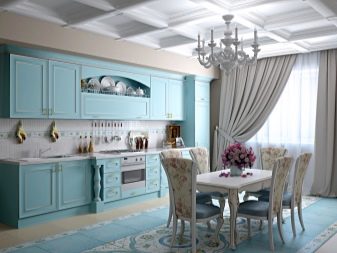


However, all the same excessive contrast is not typical for the Provencal atmosphere... But the barely noticeable manipulations of halftones turn out to be much more appropriate and correct. In another version, blue and sand paints are combined. This approach seems to reproduce the coast of the French Riviera.


Judging by the reviews, the atmosphere is incredibly cozy.
A good alternative can be a mint color, introducing it into the atmosphere will immediately refresh the space and make it a little cooler. At the same time, comfort is ensured. With a lack of light, a room in mint tones retains its attractivenesshowever, over-concentration of this color can lead to the loss of aesthetic benefits. Light woods can be used to dilute mint tones. Even if these are only small accessories, the result will be pleasant.

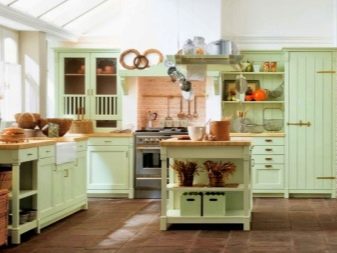
As for turquoise tones, they are considered ideal for the style of Provence. Designers associate turquoise with the sea sparkling in the sun's rays. This color is very diverse, like the very element of the ocean. At will, he can express both softness and calmness, and a dynamic attitude. The turquoise color is advised to be used in conjunction with warmer tones.
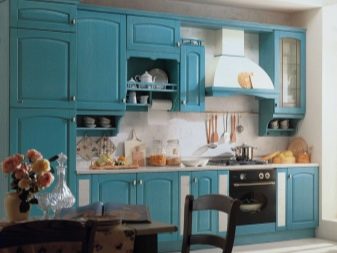
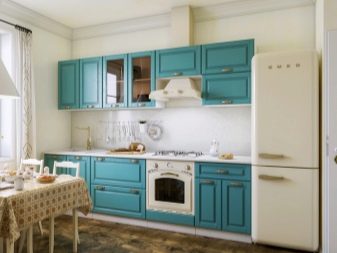
Gray tone is no less popular among professionals. There is no reason to consider him impersonal and expressionless, as many people believe. It is the gray color that leads in the variety of shades, which is why it is appreciated by painters.


But you need to understand that in its pure form, gray paints are almost never used, they are usually mixed with other shades.
If the white and light gray base seems unsuitable, you can safely start from the beige tones. But in order to embody the ideas characteristic of Provence, it is required to add natural colors:
- yellow;
- blue;
- pale green tint.
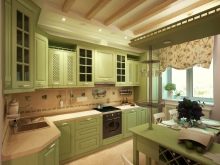
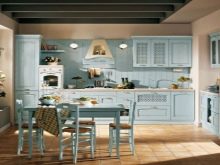
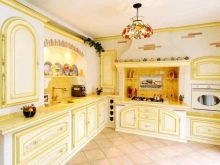
Contrasting colors are a good choice. Dark types of wood and similar finishes of lampshades and chairs are perfectly combined with a beige or gray base. Small Provencal kitchens are trying to be decorated as light as possible. Sometimes the colors that distinguish individual pieces of furniture can be repeated in other interior items. White and turquoise paints are advised to be combined with large brown details.
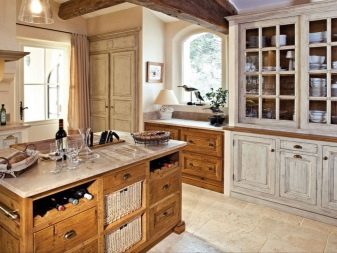
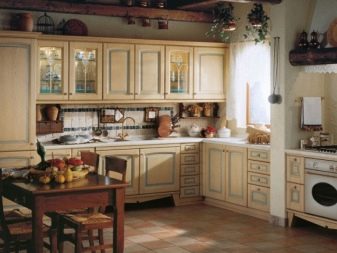
At the end of the second decade of the 21st century, the use of pistachio color is becoming a fashionable trend. It helps to make the room look fresh and interesting. But whatever the specific color scheme, elegant furniture and well-chosen accessories play a very important role. The general concept of coloring is selected in such a way as to create the idea of simplicity and reliability of the composition.

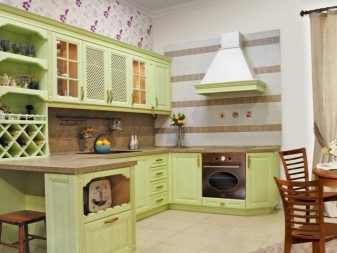
And yes, whatever color is used, it should be formed with paints and finishing materials resistant to kitchen conditions.
As for modern interpretations of Provence, colors can be used in them:
- ivory;
- snow white;
- Ivory.
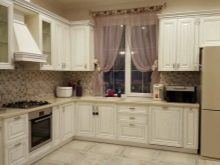
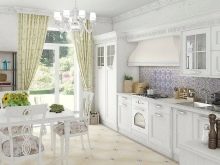
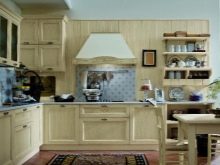
Finishing options
Walls
The kitchen will be actively used by both adults and children. Therefore, the walls must be trimmed so that they do not suffer from careless handling. Ceramic inserts are used in the working areas. They are separated from the flooring with a technological joint, which helps to eliminate the harmful effects of thermal expansion. In some cases, the walls are completely tiled. True, you will have to work with it more thoroughly, and in some cases it makes sense to invite masters.
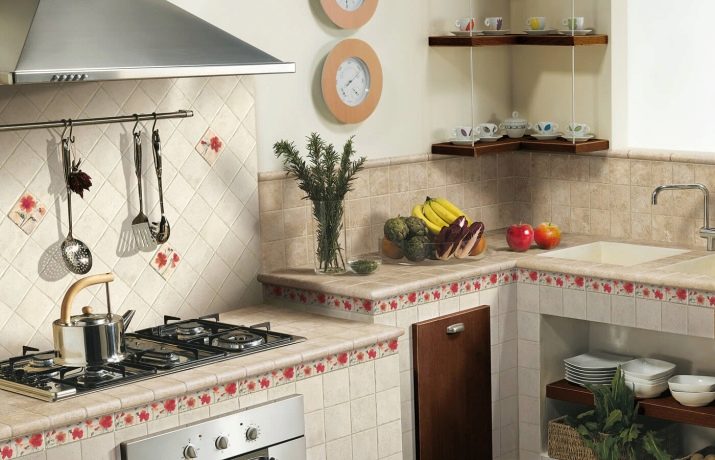
Important: no matter what materials are used, one cannot deviate from the general canons of Provence and allow a mismatch between different elements.
Instead of tiles, they often use:
- natural stone;
- synthetic stone;
- facing brick.
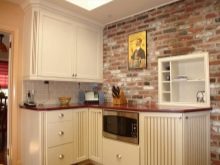
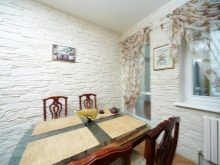
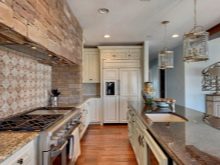
Sometimes murals are glued to the walls. A very advantageous move with them is the creation of "windows" and "doors". If you don't like this option, you can think about schemes with artistic painting or use artificially cracked plaster.
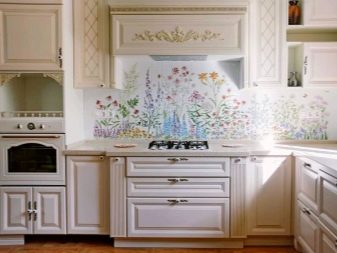
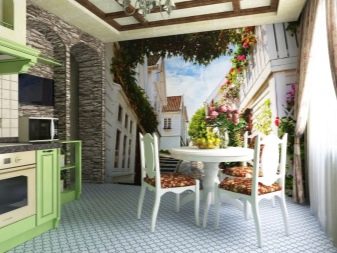
Modern technologies make it possible to imitate any kind of craquelure without lowering the strength of the decorative material.
The main hot zone is nevertheless decorated with ceramic tiles in most apartments. It has such advantages as:
- preservation of integrity and external attractiveness after repeated cleaning;
- inability to absorb fat and saturate with odors;
- absolute resistance to high temperatures;
- excellent resistance to high humidity.
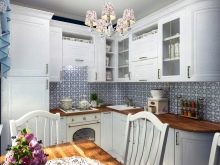
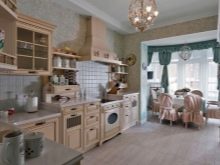
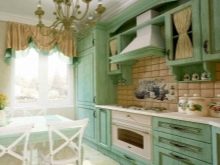
For kitchen aprons, tiles are the ideal choice. In order not to spend too much money, it is advisable to limit yourself to a couple of rows of tiles. Decorative plaster is placed over it. But at the same time, it must be remembered that in the interior, metal and wood, varnish and glass should be combined as competently as possible.
There are special series of kitchens that use dissimilar ceramics, complemented by embossed details. These types of tiles cannot be the main ones in the room. However, they work extremely well as edging and decorative inserts. Ceramics are also used for cladding furniture. This solution allows you to mask protruding corners that cannot be removed according to safety standards.
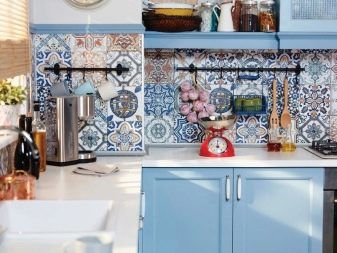

If the walls are plastered in Provencal cuisine at least partially, then the material must be applied roughly so that the surface is visually uneven - this corresponds to the canons of style. A brick that shines through the plaster is very welcome. A more modern take on Provence in the kitchen uses textured plaster. But you can do otherwise, sheathing the walls with boards for painting.
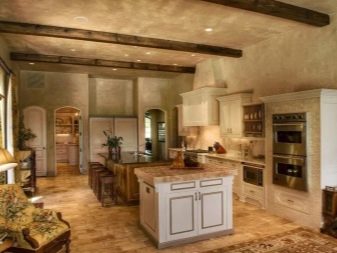
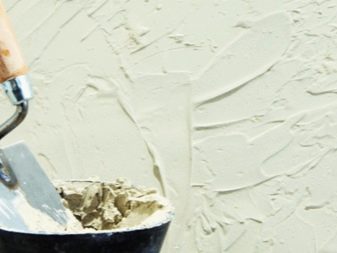
This solution is no worse than tiles or various types of stone.
Floor
Most often, the floor in the kitchen is covered with ceramic tiles. It is only necessary to take into account that it must correspond in tone to the main shade. To prevent the floor from being too cold, screed-mounted heating systems are used. Only tiles with a non-slip top coat should be selected. Regardless of whether the kitchen is made with or without a bar counter, wood flooring is popular.
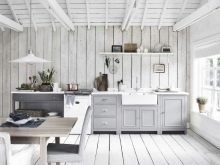
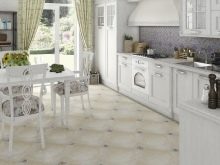
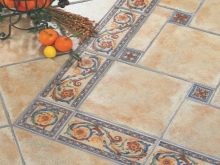
But if consumers still prefer ceramic tiles, they usually have beveled corners. Such blocks are distinguished by terracotta or light brown colors. Returning to wood floors, it should be noted that their surface can sometimes look as if there was no treatment. Of course, in fact, the boards are thoroughly processed to exclude the slightest appearance of splinters and burrs. In Provencal interiors, they are completely unacceptable:
- parquet;
- laminate;
- all types of carpets;
- linoleum of any brand.
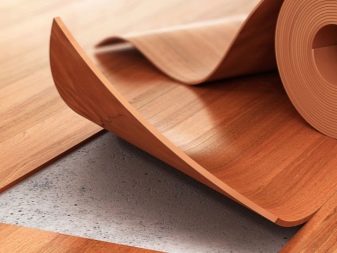
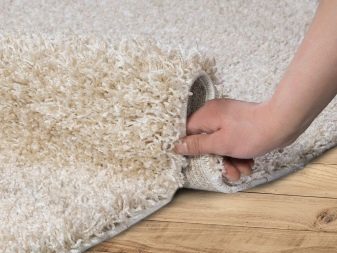
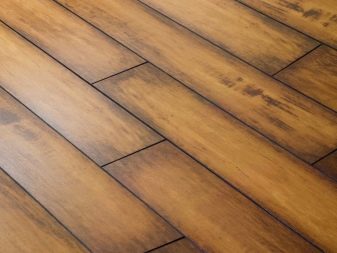
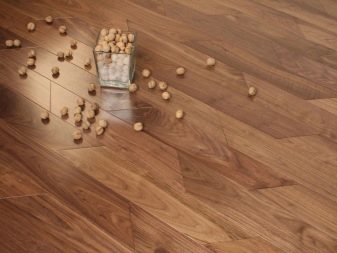
Ceiling
When decorating ceilings in Provencal kitchens, massive wooden beams are often used. Important: this element has only a decorative value and cannot be used as a load-bearing structure. It is imperative to remember that beams are used only in rooms with high ceilings. If you plan to build in spotlights, a two-level plasterboard ceiling becomes an excellent choice.
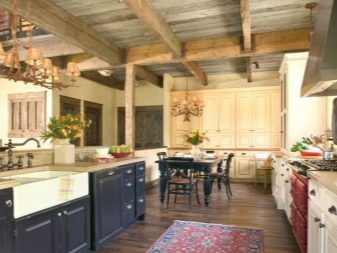
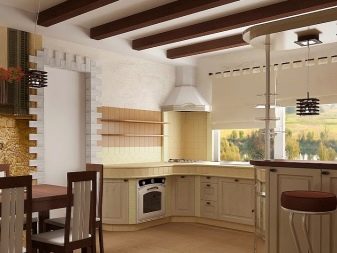
Wooden ceiling structures are usually painted with light colors.
If the ceilings in the Provencal kitchen are made of wood, then preference should be given to untreated surfaces. At the very least, they must maintain the natural pattern of the texture. But there are also Provencal hinged-type structures. They are installed much faster than plastering. And the installation of drywall sheets takes longer.
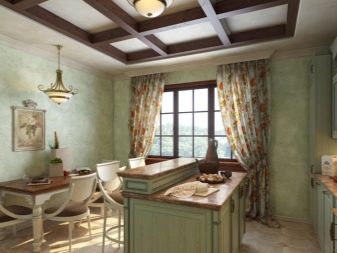
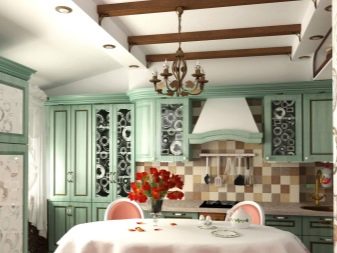
In new buildings, staining is not very well suited. The ceiling will crack within a few months and will soon require rework. Stretch structures perfectly smooth out even very large irregularities that other solutions cannot cope with. Importantly, the appearance of dirt and dust is almost excluded. Aesthetically, a lot depends on the correct choice of canvas.
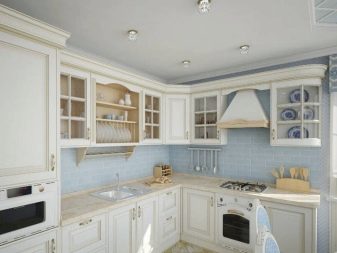

Designers recommend stretching ceilings with a matte sheen in the Provencal kitchen. You can choose white or any other light color that only suits a particular interior. The choice between a smooth or embossed film is determined only by your own taste. Glossy or very bright fabrics will absolutely not work.
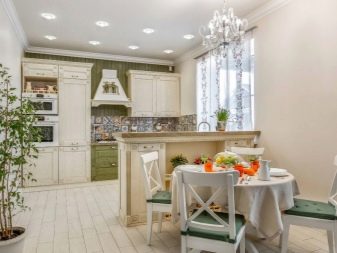

To eliminate the appearance of a characteristic unpleasant odor, it is advised to give preference to solutions made of polyester fabrics.
Apron
Decorating this area of the kitchen is just as important as decorating other wall surfaces. The completeness of the image of the room depends on it. The choice of options for the Provencal apron is very large. Wall panels are often used. This material is different:
- quick installation;
- multifunctionality;
- excellent sound insulation;
- hygiene;
- ease of cleaning and maintenance;
- low cost (upon purchase and upon installation).

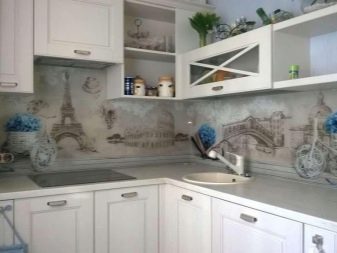
PVC panels are of excellent quality. The sleek appearance of these panels makes them an excellent choice for the kitchen. The products are completely adjacent to the walls, it is almost impossible to notice the joints between the blocks. Some manufacturers produce a wall sheet in the lining format with a width of 0.1 m and a length of up to 3 m. There are also aprons made of soft plastic grades that look like a mosaic.
However, the use of PVC in kitchen aprons is severely limited by the low thermal resistance of this material. It is also not very durable. Also, PVC tends to fade when exposed to sunlight. A more attractive and stable alternative is MDF. This material:
- paint;
- laminate;
- covered with veneer.
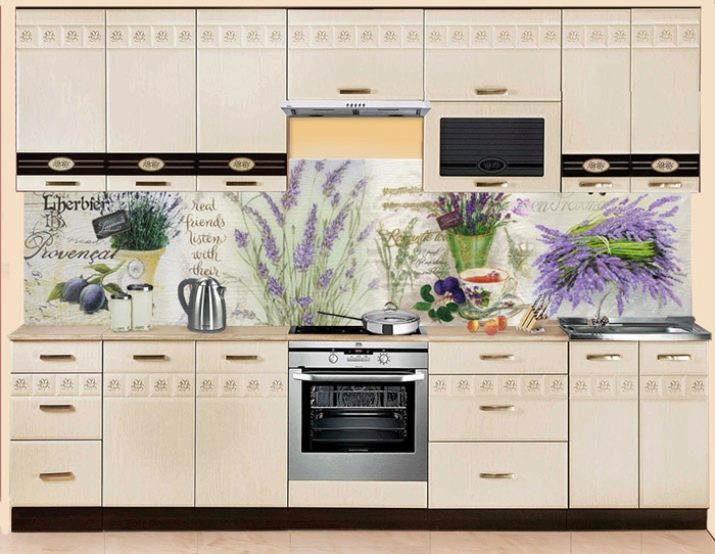
But MDF cannot be placed above the slab itself. In addition, even the best examples of such panels do not look very natural. Therefore, the overwhelming majority of designers and ordinary customers prefer not to mess with panels of any kind, but to use ceramic tiles in the spirit of patchwork. The difference may relate to shape, ornament, type of patterns and colors. However, with all the differences in the tiles, they must be harmoniously combined with each other.

Important: if a patchwork scheme is chosen, the kitchen as a whole is decorated as neutral as possible. This will avoid cluttering the room with dissimilar paints. Aged tiles (rustic) are a good alternative to patchwork. It looks as vintage as possible and adds a vintage feel to the space. The underlined roughness of such tiles is fully consistent with the basic canons of Provence.
Some people believe that it is best to decorate an apron with a panel. They are covered with mosaics, painted by hand or decorated by photo printing. Mosaic structures are made from the following materials:
- glass;
- porcelain stoneware;
- plastics;
- ordinary granite;
- metal elements.
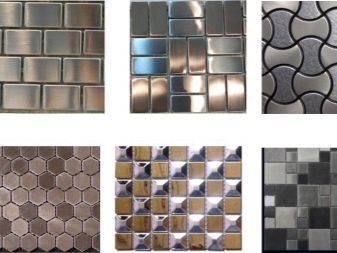
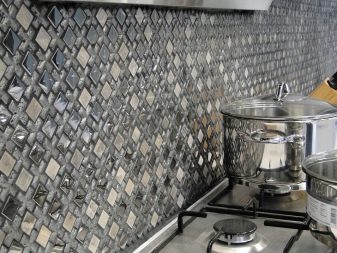
Mosaic tile details can have the most intricate facets. Moreover, they are most often small, the side is 0.02-0.05 m. In the retail network, mosaics are most often sold not by tessera, but by a matrix basis. The size of the die is approximately 0.3 x 0.3 m. To comply with the canons of the Provence style, you need to apply drawings of the appropriate subject:
- village images;
- Mediterranean landscapes;
- wildflowers.
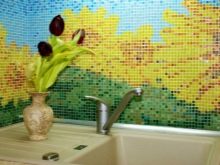

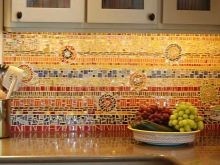
Important: photo printing is much cheaper than hand painting. It should be used with a limited overall budget.
You will have to pay a very high price for aprons made of natural stone. Its advantages are long service life and resistance to dirt. Cheaper synthetic material can easily become clogged.
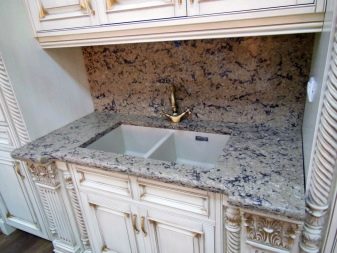
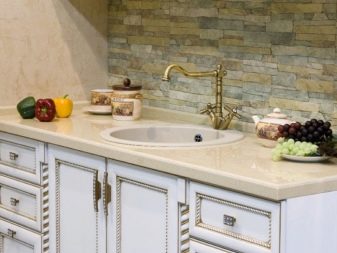
Furniture selection
Having dealt with the materials of the main surfaces of the kitchen, you need to move on to considering furniture that is suitable for the Provence style. All furniture, including kitchen units and chairs, must be made strictly from natural wood. Only with a limited budget can you use chipboard or MDF structures. But one must understand that any sophisticated person will immediately understand that this is not a real Provencal atmosphere. Headsets can be painted in the following colors:
- blue;
- White;
- pistachio;
- sand;
- blue.

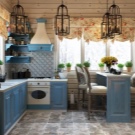
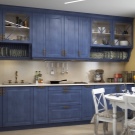
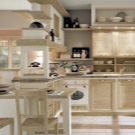
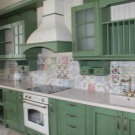
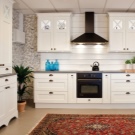
In most cases, Provencal cabinets are equipped with open shelves. They are closed with doors only occasionally. Kitchens in the spirit of Provence are predominantly equipped with overhead cabinets, because this accentuates the rustic origin of the interior. To accommodate modern household appliances, as well as other items that do not fit into the canon, closed cabinets are used. Tables and chairs must be made of natural wood, but the use of forged parts and curly legs is at the discretion of customers.
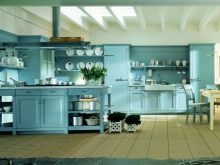
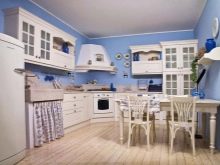
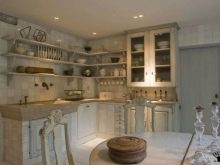
Designers believe that the Provencal style is ideally expressed in a massive dining table. Then he plays the role of a dominant and is placed in the center. Round tables are recommended to be surrounded by elegant chairs. A rectangular table is furnished with benches or benches. Upholstered furniture in Provencal cuisine is selected with an unobtrusive color and the same patterns.
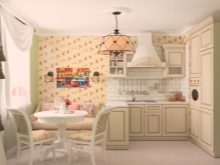
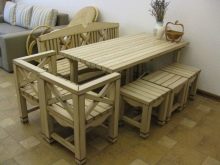
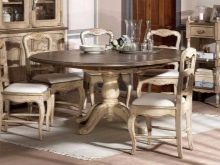
Organization of lighting
The issue of lighting in a Provence style kitchen is touched upon unreasonably rarely in comparison with furniture, colors and materials used. Meanwhile, it is the lamps of the corresponding type that perfectly express the flavor of the south of France. There are options with imitation of grapevine or ivy by openwork forging. Also used are lighting fixtures with glass and fabric shades.
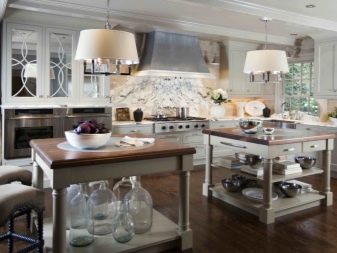
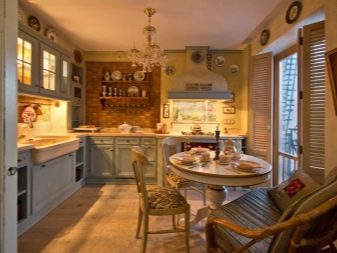
In this case, painting with floristic motives must be used.
Porcelain and wood are used to decorate the lamps. Be sure to highlight the central zone with light. It houses a large chandelier containing many bulbs. But we must not forget about auxiliary low-power lamps with a diffuse spectrum. For illumination of remote places use:
- hanging and table lamps;
- sconce;
- floor lamps.
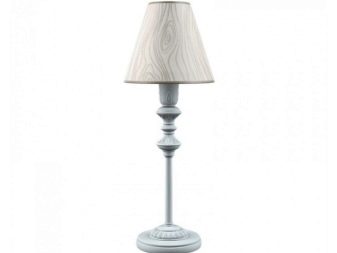
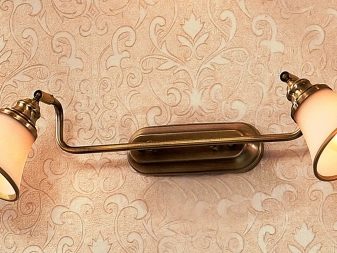
Textiles and decor elements
The most ordinary Provencal room will look aesthetically pleasing if decorated with textile accessories. A lot depends on the right choice of fabrics. Popular among both amateurs and professional designers are:
- tablecloths;
- napkins;
- curtains.
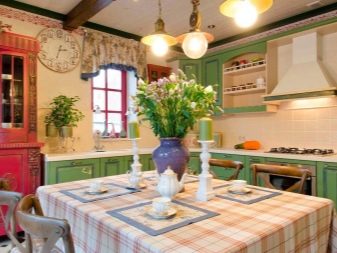
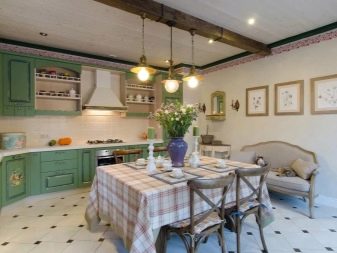
Decorating a Provencal room with textiles always implies the use of soft cold tones. The matter itself should be light and weightless. The use of embroidery and floral designs is recommended. But the use of ribbons, ruffles and cutwork embroidery remains at the discretion of the apartment owners.
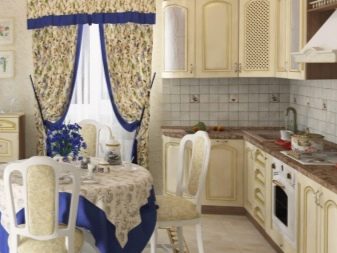
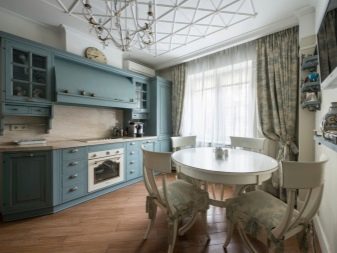
You can decorate a sofa, chairs with decorative pillows.
To create a complete look, it is advised to put a patterned tablecloth on the table. It is also necessary to take into account the nuances of using indoor flowers in a Provencal interior. They can be used almost unlimitedly. Plants with beautiful flowering are best suited. The choice between exotic and common cultures for our latitudes rests with the owners themselves.

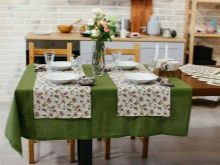
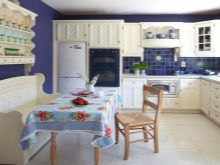
The undisputed leader is pelargonium (better known as geranium). Very good results are also given by:
- Saintpaulia;
- balsam;
- primrose;
- fuchsia;
- begonia;
- azalea;
- cyclamen;
- hoya;
- ficus;
- sansevieria.
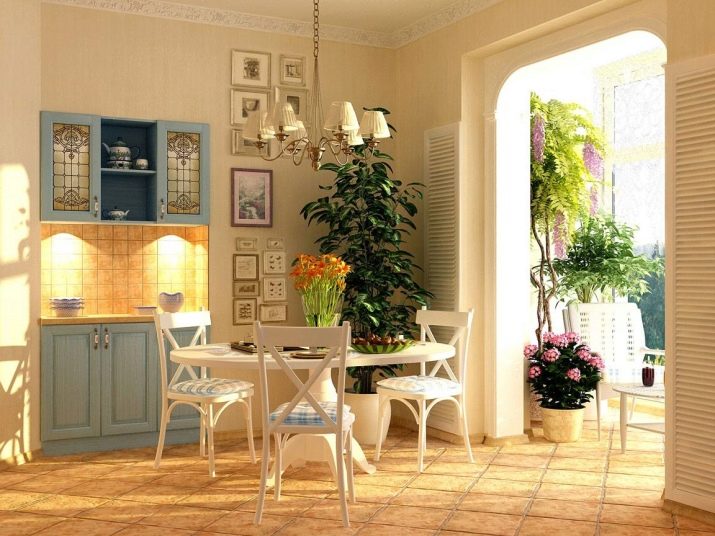
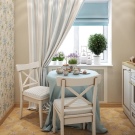
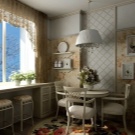
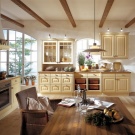
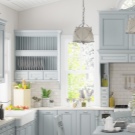

A typical Provence design technique is decorating open shelves with earthenware. An additional plus in this case will be the use of ivy.
It is worth focusing on such subtleties as Provence-style paintings and posters. They select paintings depicting olive branches, flowers in vases and pots. Be sure to take into account the size of the paintings. A huge canvas on ¾ of the wall in a small room will look frankly ugly. Likewise, do not use modest-sized images on a large wall.
Lavender is a very good subject for Provencal cuisine. She is shown both in the form of laconic still lifes, and in the form of spacious meadow and field landscapes. Other suitable plots would be:
- roses;
- green meadows;
- grape;
- culinary process and products;
- farm animals.
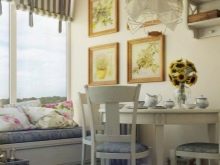
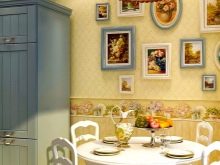
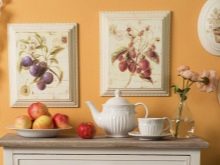
Interesting ideas
An original step in the design of a Provence style kitchen is to mix this style with loft elements. They try to paint the ceilings and part of the walls in different shades of white. The best demonstration of the industrial style, however, is brickwork. To connect two dissimilar parts of space, it is recommended to manipulate white.
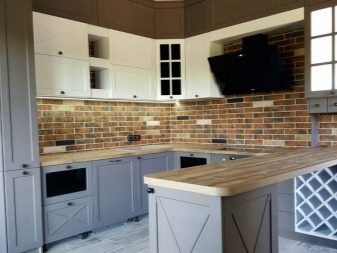
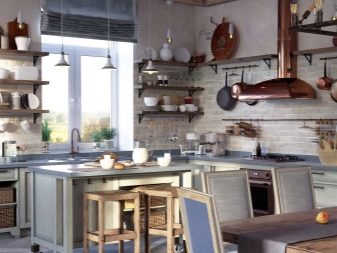
Both stylistic tendencies allow for decking or wood-look laminate flooring.
Windows in the spirit of Provence are usually made high, from floor to ceiling. But you can do otherwise by making a crate for an ordinary double-glazed window that imitates natural wood. Windows are often decorated with wickerware and decorative balls.
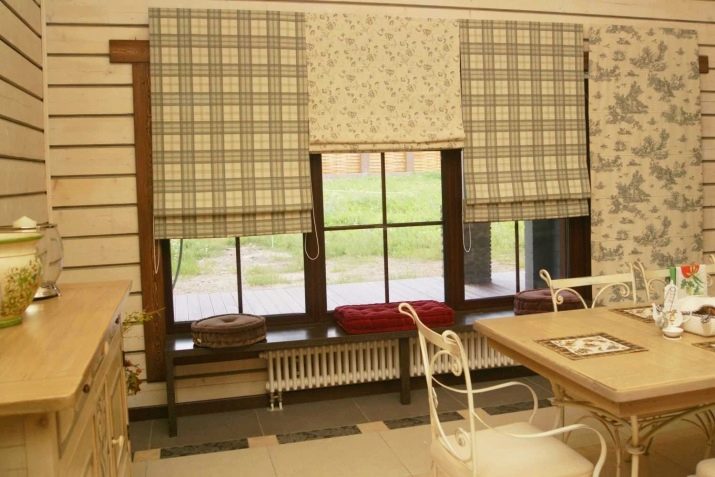
Furniture will look nicer if it has a worn surface and minor, well-thought-out imperfections. An extraordinary shape mixer will be a good addition to the southern French interior.
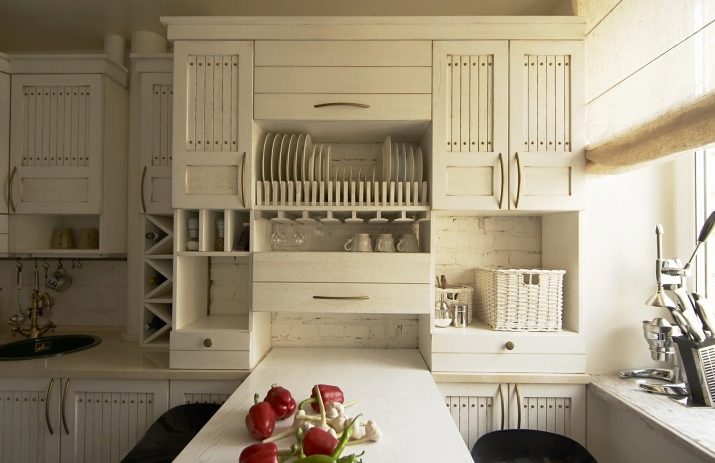
Curtains with floral patterns turn out to be an original accessory. You can also consider additional elements:
- lamps with a fabric shade on an openwork metal suspension;
- rejection of cabinets in favor of shelves and hanging fixtures;
- kitchen island with storage system and sink.

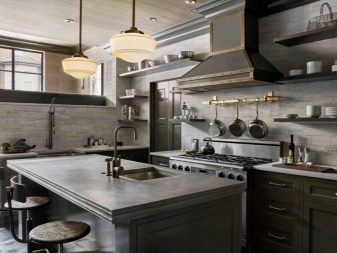
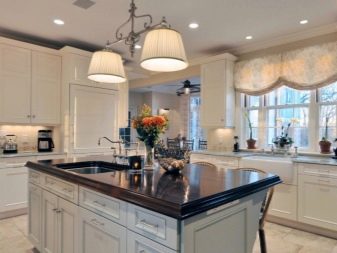
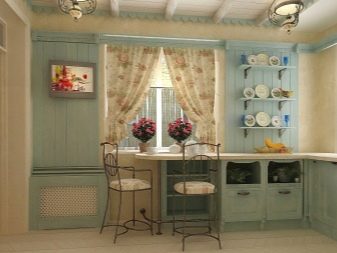
Successful examples
The first good example that deserves attention is shown in the photo below. Shown are two walls, in the design of which they used a lot of light colors. Stylish black and dark elements are used as accents.
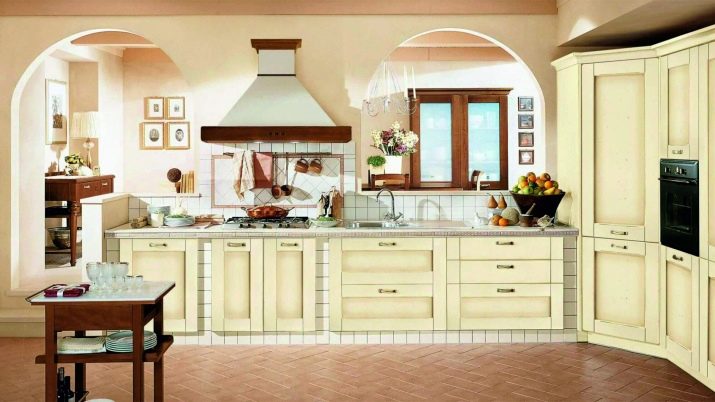
This figure clearly shows how elegant the combination of a checkerboard floor, a wicker chair and light furniture is. Symmetrical pendant lights look very nice.
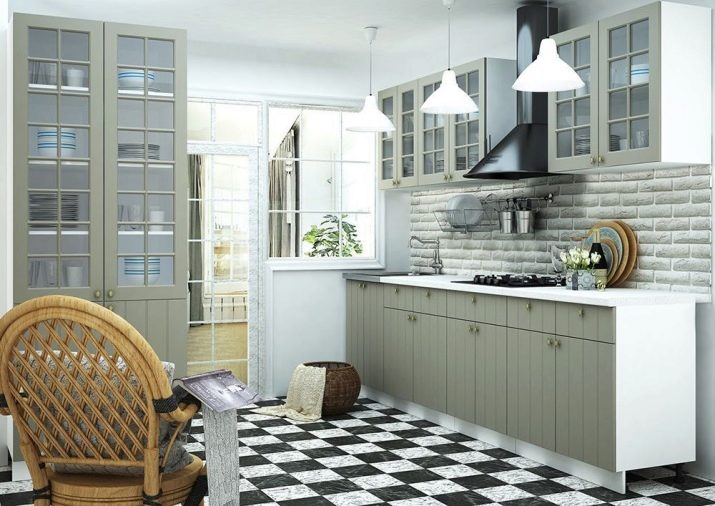
For information on how to equip a Provence style kitchen, see the video below.








